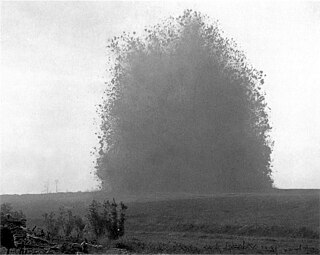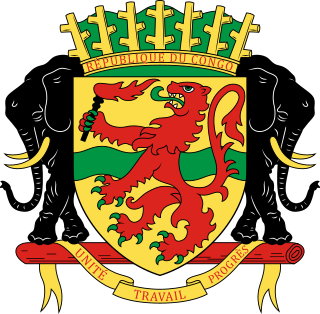The Armed Forces of the Republic of the Congo, also less formally denoted as the Forces armées congolaises or its acronym FAC, are the military forces of the Republic of the Congo. They consist of the Congolese Army, the Congolese Air Force, the Congolese Marine (Navy), and the Congolese National Gendarmerie. The dissolution of French Equatorial Africa in 1958, and France's impending military withdrawal from the Congo in August 1960, provided the impetuous for the formation of the FAC. The FAC and state paramilitary agencies are headed by an Armed Forces Chief of General Staff, usually appointed by the President of the Republic of the Congo. Major General Guy Blanchard Okoï has served as chief of staff since 2012.

Kinshasa, formerly Léopoldville, is the capital and largest city of the Democratic Republic of the Congo. Once a site of fishing and trading villages situated along the Congo River, Kinshasa is now one of the world's fastest growing megacities.

Brazzaville is the capital and largest city of the Republic of the Congo. Constituting the financial and administrative centre of the country, it is located on the north side of the Congo River, opposite Kinshasa, the capital city of the Democratic Republic of the Congo.

There have been many extremely large explosions, accidental and intentional, caused by modern high explosives, boiling liquid expanding vapour explosions (BLEVEs), older explosives such as gunpowder, volatile petroleum-based fuels such as gasoline, and other chemical reactions. This list contains the largest known examples, sorted by date. An unambiguous ranking in order of severity is not possible; a 1994 study by historian Jay White of 130 large explosions suggested that they need to be ranked by an overall effect of power, quantity, radius, loss of life and property destruction, but concluded that such rankings are difficult to assess.
The Lagos armoury explosion was the accidental detonation of a large stock of high explosives at a military storage facility in the city of Lagos, Nigeria, on 27 January 2002. The fires created by the debris from this explosion burnt down a large section of Northern Lagos, and created a panic that spread to other areas. As people fled the flames, many stumbled into a concealed canal and drowned. The explosion and its aftermath are believed to have killed at least 1,100 people and displaced over 20,000, with many thousands injured or homeless. The government of Nigeria launched an enquiry, which blamed the Nigerian Army for failing to properly maintain the base, or to decommission it when instructed to do so in 2001.

At approximately 12 p.m. local time on Saturday, March 15th, 2008, an ex-military ammunition depot in the village of Gërdec in the Vorë Municipality of Albania, U.S and Albanian munitions experts were preparing to destroy stockpiles of obsolete ammunition. The methodical destruction of the old ammunition was supposed to occur with a series of small, controlled explosions. However, a chain of events led to the entire stockpile detonating simultaneously. Hundreds of houses were demolished within a few kilometres of the depot, while car windows on the Tirana-Durres highway were shattered by the main explosion, which involved more than 400 tonnes of propellant in containers. A large fire caused a series of smaller but powerful explosions that continued until 2 a.m. on Sunday. The explosions could be heard as far away as the Macedonian capital of Skopje, 170 km (110 mi) away.

The 2008 Chelopechene explosions were a series of explosions that began early on Thursday morning 3 July 2008 at around 6:30 am local time at a munitions depot in the suburb of Chelopechene, 10 kilometres east of the centre of the Bulgarian capital, Sofia. The initial explosions were powerful enough to be heard in the entire capital and surrounding villages. The depot was part of a military facility that specialised in dismantling obsolete ammunition.

Pierre Ngolo is a Congolese politician who has been Secretary-General of the Congolese Labour Party (PCT) since August 2011. He was First Secretary of the National Assembly of Congo-Brazzaville from 2002 to 2012. He has served as the President of the Senate of Congo-Brazzaville since 2017.
The 2011 Democratic Republic of the Congo coup d'état attempt was an alleged coup attempt against President Joseph Kabila on February 27, 2011.

Parliamentary elections were held in the Republic of the Congo on 15 July 2012. A second round was held on 5 August 2012. The second round was previously moved forward to 29 July, without explanation, but ultimately was held on the original date.
There is a large community of Chinese migrants residing in the Republic of Congo.
Republic of Congo–India relations are the international relations that exist between India and the Congo. Congo maintains an embassy in New Delhi. India opened an embassy in Brazzaville in November 2019.
The following is a timeline of the history of the city of Brazzaville, Republic of the Congo.
The Mbuba road tanker explosion was the traffic collision and explosion of a tank truck on 6 October 2018 in Kongo Central, in the Democratic Republic of the Congo. The vehicle collided with another truck in the village of Mbuba and later exploded, killing at least 50 people and injuring more than 100 others.
The 2019 Israeli airstrikes in Iraq began as unidentified drone or aircraft bombings of the Iranian-backed Popular Mobilization Forces (PMF) bases in Iraq starting on 19 July 2019. The strikes targeted Iranian proxy groups, based in Iraq, as well as IRGC operatives.
During the afternoon of 7 March 2021, a series of four explosions occurred at a military barracks in the neighborhood of Nkoantoma, a district of Bata, the largest city and commercial capital of the Central African country of Equatorial Guinea. At least 107 people died, and more than 600 others were injured, while significant infrastructural damage also occurred throughout the city.
Annette Kouamba Matondo is a film director, journalist and blogger from the Republic of the Congo. She is editor of La Nouvelle République, a newspaper based in Brazzaville. Her first film, On n'oublie pas, on pardonne, commemorates the disappearance of 353 refugees in 1999 from the port in Brazzaville. In it the actress Sylvie Dyclos-Pomos writes a play based on the event. The title uses a phrase associated with Nelson Mandela. The film was described by film-maker Beti Ellerson as "cathartic". Her second film, De quoi avons-nous peur? raises awareness of censorship and self-censorship in journalism. In a third film, Au-delà de la souffrance, she draws attention to the explosion on 4 March 2012 at an ammunition depot in Mpila.







